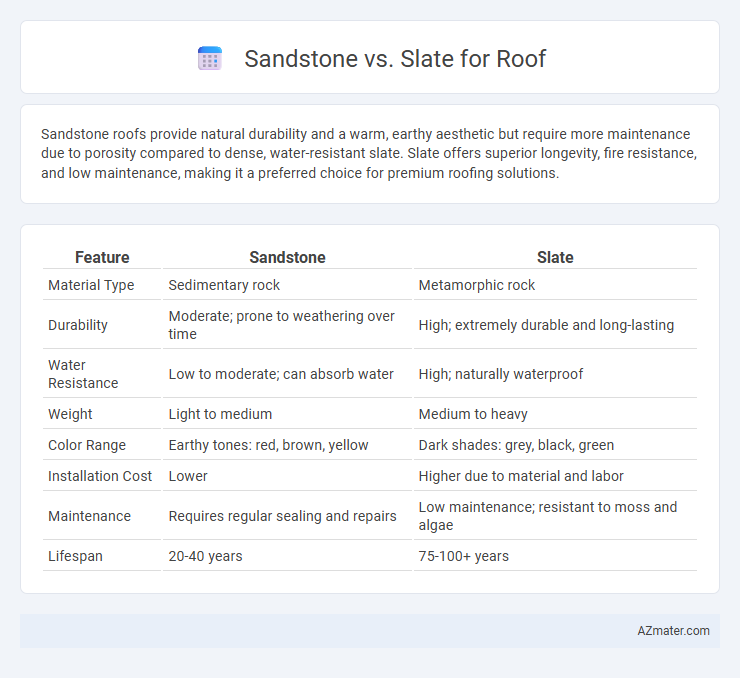Sandstone roofs provide natural durability and a warm, earthy aesthetic but require more maintenance due to porosity compared to dense, water-resistant slate. Slate offers superior longevity, fire resistance, and low maintenance, making it a preferred choice for premium roofing solutions.
Table of Comparison
| Feature | Sandstone | Slate |
|---|---|---|
| Material Type | Sedimentary rock | Metamorphic rock |
| Durability | Moderate; prone to weathering over time | High; extremely durable and long-lasting |
| Water Resistance | Low to moderate; can absorb water | High; naturally waterproof |
| Weight | Light to medium | Medium to heavy |
| Color Range | Earthy tones: red, brown, yellow | Dark shades: grey, black, green |
| Installation Cost | Lower | Higher due to material and labor |
| Maintenance | Requires regular sealing and repairs | Low maintenance; resistant to moss and algae |
| Lifespan | 20-40 years | 75-100+ years |
Understanding Sandstone and Slate Roofing Materials
Sandstone roofing offers natural durability and a unique, earthy texture created from compacted sand grains bonded with minerals, ideal for rustic or traditional architectural styles. Slate roofing, formed from fine-grained metamorphic rock, provides exceptional strength, water resistance, and a sleek, elegant appearance with a variety of natural color options. Both materials offer long lifespans and require skilled installation, but slate tends to be denser and more expensive compared to the relatively softer and more porous sandstone.
Key Differences Between Sandstone and Slate Roofs
Sandstone roofs feature a natural, granular texture and typically exhibit a range of warm, earthy tones, while slate roofs are known for their smooth, fine-grained surface and consistent dark gray to black color. Slate is more durable and resistant to weathering, with an impressive lifespan often exceeding 100 years, whereas sandstone is more porous, requiring regular maintenance to prevent water damage and erosion. The weight of slate is considerably heavier, necessitating a stronger roof structure compared to the lighter, more flexible sandstone tiles.
Aesthetic Appeal: Sandstone vs Slate Roof Design
Sandstone roofs offer a warm, earthy aesthetic with natural hues ranging from soft yellows to deep reds, complementing rustic and traditional architectural styles effectively. Slate roofs provide a sleek, elegant appearance with smooth textures and colors spanning from dark gray to blue and green, ideal for sophisticated and classic designs. The choice between sandstone and slate significantly influences the overall roof design, enhancing either a natural charm or a refined, timeless look.
Durability and Longevity Comparison
Sandstone roofing offers moderate durability with a lifespan of 30 to 50 years but is prone to erosion and weathering in harsh climates. Slate roofs boast exceptional durability and longevity, often exceeding 75 to 100 years due to their dense, non-porous structure that resists water infiltration and frost damage. The superior hardness and low water absorption of slate make it a preferred choice for long-term roofing solutions requiring minimal maintenance.
Weather Resistance: Performance in Different Climates
Sandstone offers excellent weather resistance with high durability against heat and UV radiation, making it suitable for hot, arid climates, while slate provides superior water resistance and frost durability, ideal for cold, wet environments. Slate's low porosity prevents water absorption and reduces freeze-thaw damage, ensuring long-term performance in regions with heavy rainfall and snow. Sandstone's porous structure requires sealing treatments to enhance resistance in humid or freeze-prone areas, but it remains a cost-effective option in moderate climates with less severe weather fluctuations.
Installation Process and Complexity
Sandstone roofing requires precise cutting and anchoring due to its granular texture and variable thickness, making installation moderately complex. Slate roofing involves delicate handling and skilled labor to fit thin, brittle slabs securely with specialized nails or hooks, increasing installation time and complexity. Both materials demand experienced installers, but slate's fragility and need for exact alignment make its installation more intricate compared to sandstone.
Maintenance Requirements for Sandstone and Slate Roofs
Sandstone roofs require regular inspection to prevent erosion and water infiltration due to their porous nature, with periodic sealing recommended to maintain durability. Slate roofs demand minimal maintenance but benefit from routine checks for cracked or slipped tiles to ensure long-term weather resistance. Both materials need professional assessment to address any damage promptly and preserve structural integrity.
Cost Comparison: Initial Investment and Long-Term Value
Sandstone roofing typically involves a lower initial investment compared to slate due to its more abundant availability and easier quarrying process. Slate roofs offer superior durability and longevity, often lasting over 100 years, which may justify their higher upfront cost through reduced maintenance and replacement expenses. Considering long-term value, slate's resistance to weathering and minimal upkeep often results in better cost-efficiency over decades despite the steep initial price.
Environmental Impact and Sustainability
Sandstone roofing offers a natural, renewable material that requires less energy-intensive processing compared to slate, reducing its overall carbon footprint. Slate, while highly durable and long-lasting, involves quarrying practices that can lead to habitat disruption and higher energy consumption during extraction and transportation. Choosing sandstone can enhance sustainability through its lower embodied energy and better integration with eco-friendly construction methods.
Choosing the Right Roofing Material: Sandstone or Slate?
Choosing between sandstone and slate for roofing hinges on factors like durability, aesthetic appeal, and regional climate suitability. Slate offers superior longevity, water resistance, and a natural, elegant appearance, making it ideal for harsh weather conditions and high-end architectural styles. Sandstone provides a unique textured look and is generally more affordable but requires more maintenance due to its porous nature and less resistance to weathering.

Infographic: Sandstone vs Slate for Roof
 azmater.com
azmater.com